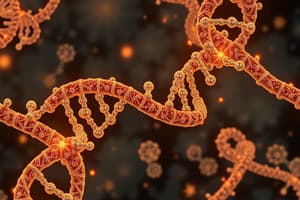Podcast
Questions and Answers
What happens to a cell when its telomeres shorten beyond a critical length?
What happens to a cell when its telomeres shorten beyond a critical length?
- The cell continues to divide indefinitely.
- The cell becomes cancerous.
- The cell undergoes apoptosis. (correct)
- The cell repairs its DNA efficiently.
Which of the following statements about telomerase is true?
Which of the following statements about telomerase is true?
- Telomerase is absent in all cancer cells.
- Telomerase allows certain cells to divide indefinitely. (correct)
- Telomerase is responsible for DNA repair in most cells.
- Telomerase prevents telomere shortening in all somatic cells.
Who discovered the function of telomerase and was awarded a Nobel Prize for it?
Who discovered the function of telomerase and was awarded a Nobel Prize for it?
- Francis Crick
- Elizabeth Blackburn (correct)
- Rosalind Franklin
- James Watson
What is a consequence of telomere shortening during cell replication?
What is a consequence of telomere shortening during cell replication?
Which mechanism is NOT part of the DNA repair mechanisms mentioned?
Which mechanism is NOT part of the DNA repair mechanisms mentioned?
What is the primary structural component of telomeres?
What is the primary structural component of telomeres?
Which protein is responsible for binding to telomere ends to maintain their length?
Which protein is responsible for binding to telomere ends to maintain their length?
What indicates a true end of DNA as opposed to a break when considering telomere function?
What indicates a true end of DNA as opposed to a break when considering telomere function?
What is the primary function of telomerase in relation to chromosomes?
What is the primary function of telomerase in relation to chromosomes?
Which of the following diseases is NOT associated with telomere shortening?
Which of the following diseases is NOT associated with telomere shortening?
Flashcards
Telomeres
Telomeres
Protective caps at the ends of chromosomes that shorten with each cell division.
Telomerase
Telomerase
An enzyme that replenishes telomeres, allowing cells to continue dividing.
Apoptosis
Apoptosis
The process of programmed cell death that occurs when telomeres shorten too much.
Base Excision Repair
Base Excision Repair
Signup and view all the flashcards
Double Strand Break Repair
Double Strand Break Repair
Signup and view all the flashcards
Telomere Structure
Telomere Structure
Signup and view all the flashcards
Function of Telomeres
Function of Telomeres
Signup and view all the flashcards
Telomerase and Aging
Telomerase and Aging
Signup and view all the flashcards
Study Notes
DNA Repair Mechanisms and Telomeres
- DNA repair mechanisms are crucial for maintaining genomic stability.
- Telomeres and telomerase play a vital role in the replication and aging process of cells.
Learning Outcomes
- Students will be able to explain the role of telomeres and telomerase in cell replication.
- Students will be able to describe different DNA repair mechanisms.
Telomeres and Telomerase
- Telomeres shorten with each cell division.
- Shortened telomeres beyond a critical length trigger apoptosis (cell death).
- Senescence (aging) can occur due to telomere shortening.
- In germ cells and some cancer cells, telomeres are protected from shortening by the presence of telomerase.
- Telomerase maintains telomere length, preventing aging and enabling continuous cell division.
- Telomerase is a rejuvenating enzyme.
- Telomerase replenishes telomeres.
Telomere Structure
- Telomeres are complexes of repetitive DNA and proteins.
- They are located at the ends of chromosomes.
- Tandem repeats of TTAGGG make up telomeres.
- The GT-rich strand is longer.
- The single-stranded DNA loops at the 3' end are stabilized by proteins like TRF1 and TRF2.
- Telomeres maintain telomere length.
Telomere Functions
- Telomeres maintain the structural integrity of chromosomes.
- They protect DNA from nuclease activities.
- They distinguish true chromosome ends from DNA breaks (critical in repair mechanisms).
- Removal of RNA primers during DNA replication leads to telomere shortening at the 5' end of the new strand.
- After development, telomerase synthesis stops.
- Consequently, telomere shortening occurs.
- This contributes to the aging process.
Telomerase Function
- Telomerase is a multi-subunit ribonucleoprotein.
- It contains a short RNA sequence that acts as a template for DNA synthesis.
- It maintains the length of telomeres by adding tandem repeats to the 3' end of the telomere.
Role of Telomerase in Diseases
- Age-related diseases include cardiovascular disease (CVD), type 2 diabetes, Alzheimer's disease, and osteoporosis.
- In cancer cells, telomerase expression is induced.
- This maintains telomere length, allowing cells to divide indefinitely.
- Uncontrolled cell growth results from telomere maintenance in cancer.
DNA Damage Types
- DNA-damaging agents include oxygen radicals, radiation, chemotherapeutics, polyaromatic hydrocarbons, and UV light.
- Damage types range from base mismatches to single- and double-strand breaks, insertions, deletions, abasic sites, and crosslinking (thymine dimers, DNA adducts, intra- and interstrand crosslinks, and 8-oxoguanine).
DNA Repair Mechanisms Summary
- Mismatch repair (MMR): Recognizes and corrects mismatched bases.
- Nucleotide excision repair (NER): Removes bulky DNA lesions (like thymine dimers).
- Base excision repair (BER): Removes damaged or abnormal bases.
- Direct repair (photoreactivation): Repairs thymine dimers using light energy (does not exist in humans).
- Alkylation repair: Repairs damage from alkylating agents (06-methylguanine).
- Double-strand break repair (DSBR): Repairs broken DNA strands by either non-homologous end joining (NHEJ) or homologous recombination (HR).
Disorders Associated with DNA Replication and Repair
- Xeroderma pigmentosum (XP): NER deficiency, causing extreme sensitivity to UV.
- Cockayne syndrome (CS): TC-NER deficiency, causing growth retardation, premature aging, and photosensitivity.
- Trichothiodystrophy (TTD): GG-NER deficiency, characterized by brittle hair and skin abnormalities.
- Bloom's syndrome (BS): Deficiency in DNA-repair related helicase, impacting DNA replication and repair increasing the chance of cancer and other abnormalities.
- Fanconi anemia (FA): ICL repair deficiency. This leads to bone marrow failure, cancer risk, and other anomalies.
- Ataxia-telangiectasia (AT): ATM gene mutation resulting in faulty DNA damage response, causing neurological impairment and immune deficiencies.
Studying That Suits You
Use AI to generate personalized quizzes and flashcards to suit your learning preferences.




